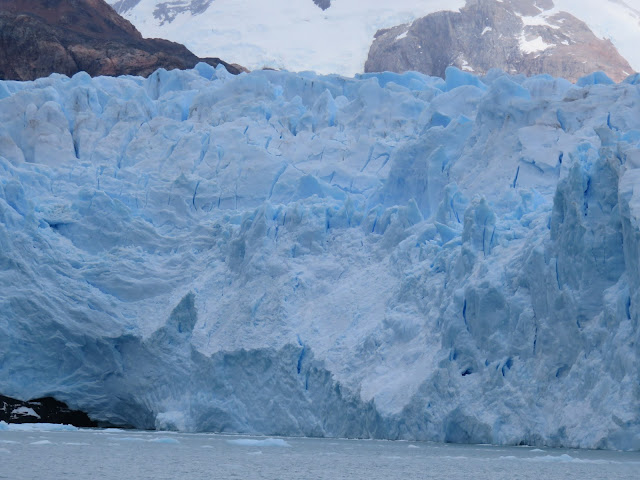After arriving at the bus station in El Calafate, we got a taxi to the Hospedaje del Norte. As we pulled up, I noticed a little boy, probably about 8 years old, standing behind the fence at the side of the hotel. He wore a blue-and-red striped shirt and a solemn look as we pulled up. He never looked away from our taxi. I snapped a picture of him. (I snap pictures of anything and everything. If you’ve traveled with me before, this is not new information.)
I knew from our previous stay that the manager lived in a little apartment on the side of the hotel with a man who I thought was her husband, as he sometimes sat at the reception desk during the day. I assumed this little boy was their son. It occurred to me that even though we had stayed at the Hosteria del Norte for 4 days earlier in the week, we never saw the little boy once during that time.
We got out of the taxi and started unloading our bags. He watched us from behind the fence the entire time. The taxi pulled away and we were about to head inside when he opened the gate and walked toward us. He looked pale, almost gaunt, like he stayed indoors a lot. Viv says he had sunken eyes.
As he approached, we greeted him with smiles. “Hola!” He did not smile, nor did he greet us back. He got close and whispered something. All we could make out was the word “brujado.” Haunted.
I snapped a couple more pictures.
“¿Que?,” Vivan asked. What?
“Este lugar es brujado,” the boy replied. This place is haunted.
We all laughed nervously. What a little jokester. Days later, we all admitted to thinking the same thing, “Dude, were we living with a ghost?”
He promptly ran away, down the street, out of sight. We went inside, stored our bags and went into town for lunch. We caught our flight later that day and arrived in Bariloche that night. We didn’t give him another thought, he was just a kid being a kid.
In Bariloche a couple of days later, we were all hanging out by the pool at our hotel. I was scrolling through some of the pictures I had taken while in El Calafate and El Chalten. I came across the ones I had taken of the little boy the day we stored our luggage at the Hospedaje del Norte. I yelled for Viv and Ant to come take a look at the pictures:
“That is creepy AF,” Ant said.
Below is a sketch that Viv did of El Niño Brujado. In my opinion, it’s pretty realistic.
Here’s one that Ant did. I think it looks like El Niño Brujado if you squint with one eye closed and a bag over your head.
* * *
Do you remember when you found out that Santa Claus doesn’t exist?
Or when you discovered that 8 cassettes for the price of S&H only was too good to be true? #damnyou #ColumbiaHouse
Or when you realized that Sam Malone’s glorious coif was just a hairpiece glued to the top of Ted Danson’s bald head?
I had a similar feeling when I found out that TOMS, the popular canvas shoe worn by many people I know and love (including myself), is just a copycat of a shoe long worn by Argentinians. If you already knew this fact, good for you.
Photo credit: AP
In Argentina, these canvas shoes are known as alpargatas, a kind of sandal or espadrille. It is believed that the alpargata is a descendent of the Egyptian sandal. Romans later modified the sandal by adding an upper for protection. The alpargata was then taken to Spain, where it took its current shape. In the 15th century, it was taken to the Americas by Spanish colonizers, soldiers and missionaries.
Alpargatas were originally made as a poor man’s shoe, and they were loved by rural workers for their comfort and versatility. The gauchos of Argentina helped to spread the popularity of the shoe. Alpargatas eventually became a popular and important part of the city wardrobe and spread to Buenos Aires and other cities. The alpargata became the everyday shoe for Argentina.
I first noticed the shoes on the gauchos at Estancia Don Silvano. The ones they wore were plain navy blue canvas with white rubber soles.
In my ignorance, I thought that it was unusual/funny that they looked so similar to TOMS. Estancia Don Silvano even sold these in the gift shop, some with rubber soles, some with rope soles. Then I started seeing people wearing these shoes in the towns we visited and in the airports while we boarded our flights. Then it occurred to me that the TOMS logo is (deliberately?) similar to the Argentine flag.
Photo credit: Tom's Shoes
I googled “TOMS shoes Argentina” and received an education. Basically, Tom of TOMS Shoes was inspired to found his company by the time he spent in Argentina. Whether or not you agree with Tom and support his company is a topic best left for places other than this blog. Suffice it to say that alpargatas are EVERYWHERE in Argentina. Exhibit A:
Next stop: Mendoza

















































































